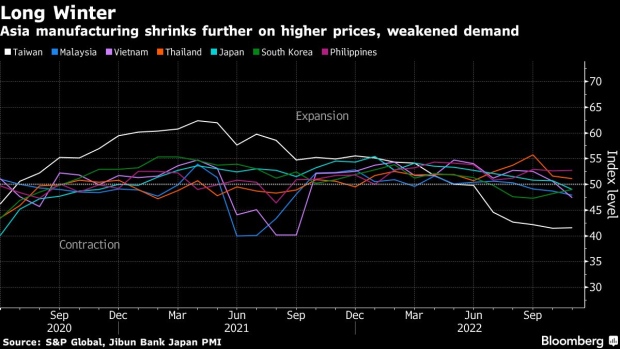Dec 1, 2022
Asia Manufacturing Activity Slumps as Factories Brace for Worst
, Bloomberg News

(Bloomberg) -- Asia’s factories struggled in November as they contended with higher costs, weakening regional currencies and cooling global demand, and the pressure is set to continue in the months ahead.
Manufacturers across the region are cutting back on output and jobs, with business sentiment becoming gloomier as they brace for a further pullback on spending from US and European customers, data from S&P Global manufacturing purchasing managers’ indexes showed Thursday.
Vietnam recorded the sharpest deterioration in the region with PMI falling to 47.4 in November from 50.6 in October -- the first time in over a year the gauge dipped below 50, the line separating expansion from contraction.
In Japan, PMI dropped below 50 for the first time in nearly two years. Electronic hubs Taiwan and South Korea were also sluggish as producers cut back on purchasing and inventory amid weaker overseas demand.
The poor PMI showings add to signs that the world’s factories are entering a long winter as global trade cools. Manufacturing had just started to recover from pandemic-related lockdowns and supply chain disruptions, making the global slowdown a rising concern.
The output downturn in Taiwan -- where PMI inched up slightly from October but was still well in contraction at 41.6 -- “underscores the weakest performance of the sector since the global financial crisis in 2009,” said Annabel Fiddes, economics associate director at S&P Global Market Intelligence, in a statement accompanying the data.
She added that firms are “not anticipating things to improve anytime soon,” based on an “incredibly downbeat” 12-month outlook.
“An increasingly challenging global economic environment” of inflationary pressure and tightening financial conditions “is expected to constrain performance in the months ahead,” she added.
In China, a gauge of manufacturing activity jointly published by Caixin and S&P Global on Thursday came in at 49.4 in November, remaining below the 50 mark for the fourth straight month. That followed dismal readings on Wednesday, when official indexes measuring manufacturing and non-manufacturing activity fell to the lowest levels since the Shanghai lockdown in April.
The impact of Covid flareups and related restrictions was evident, according to the data. Companies reduced purchasing activity and cut staff numbers further as factory output fell at a faster rate than in the previous month amid movement restrictions, S&P Global said in a statement.
Bright Spots
There were bright spots in South and Southeast Asia as factory activity in Philippines, Thailand and Indonesia continued to expand. India’s manufacturing PMI continued to outperform the rest of the region, increasing to a three-month high of 55.7 in November from 55.3 the month prior.
Export orders in India are still not feeling the pinch, “unlike rest of Asia,” said Rahul Bajoria, an economist at Barclays Plc. New orders are on the rise as the festive season increased demand although spending on discretionary consumer durables may ease in the coming months “as rising interest rates, sticky inflation and moderating economic conditions take a toll on activity,” he said.
Growth in Asia’s third-largest economy slowed to 6.3% in July-September from a year ago compared with 13.5% in the preceding quarter as manufacturing fell 4.3%. The contraction was “worrying,” according to Rajani Sinha, an economist at CareEdge.
--With assistance from Fran Wang and Anup Roy.
(Updates with India PMI and analysts comments from eleventh paragraph.)
©2022 Bloomberg L.P.


